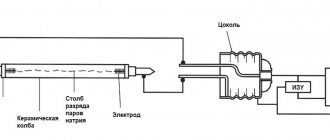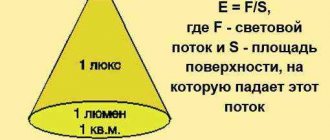Anyone who begins to study the characteristics of lamps and individual types of lamps is sure to encounter such concepts as illumination, luminous flux and luminous intensity.
What do they mean and how do they differ from each other? Let's try to understand these quantities in simple, understandable words. How they are related to each other, their units of measurement and how the whole thing can be measured without special instruments.
Density, intensity and power
The light flux density is the distribution of the beam across the spectrum, which is equal to the ratio of the light of a small area to its width. Measured in watts per nanometer.
The intensity of a light source is the module with the time-averaged energy density value in a given space. Calculated from the square of the amplitude of the light wave divided by the refractive index. It characterizes the amount of average energy that is transferred by a solar wave to a time unit through an area that is perpendicular to the wave. Lines of energy are rays.
Power is the energy transferred through radiation to an object in a certain time.
Addition: The optical section, where intensity and all radiation is studied, is ray or geometric optics.
Calculation of density, intensity and power of light flux
The essence of the phenomenon
Luminous flux is considered a physical quantity that characterizes the solar force or energy at the moment of radiation, which is transferred across the surface at a certain time. That is, this is a quantity proportional to the moment of radiation according to the spectral sensitivity of the human eye. This is the power transferred by radiation to any body.
Note! There is also a definition where it acts as a quantity that evaluates the radiation at a selective solar receiver according to its operation.
Definition from the textbook
General information
Luminous intensity is the power of the luminous flux within a certain solid angle. That is, the intensity of light does not determine all the light in space, but only the light emitted in a certain direction. Depending on the light source, the luminous intensity decreases or increases as the solid angle changes, although sometimes this value is the same for any angle if the source distributes the light evenly. Luminous intensity is a physical property of light. In this way, it differs from brightness, since in many cases, when they talk about brightness, they mean a subjective sensation, and not a physical quantity. Also, brightness does not depend on the solid angle, but is perceived in the general space. The same source with a constant luminous intensity can be perceived by people as light of different brightness, since this perception depends on environmental conditions and on the individual perception of each person. Also, the brightness of two sources with the same luminous intensity may be perceived differently, especially if one produces diffuse light and the other directed light. In this case, the directional source will appear brighter, even though the luminous intensity of both sources is the same.
Luminous intensity is considered as a unit of power, although it differs from the usual concept of power in that it depends not only on the energy emitted by the light source, but also on the wavelength of the light. The sensitivity of people to light depends on the wavelength and is expressed by the function of relative spectral luminous efficiency. The luminous intensity depends on the luminous efficiency, which reaches a maximum for light with a wavelength of 550 nanometers. This is green. The eye is less sensitive to light of longer or shorter wavelengths.
In the SI system, luminous intensity is measured in candelas
(kd).
One candela is approximately equal to the intensity of light emitted by one candle. the candle
(or international candle), is sometimes also used One candle is approximately equal to one candela.
If you measure the luminous intensity using a plane that shows the spread of light, as in the illustration, you can see that the magnitude of the luminous intensity depends on the direction towards the light source. For example, if the direction of maximum emission of an LED lamp is taken to be 0°, then the measured luminous intensity in the 180° direction will be much lower than for 0°. For diffuse sources, the luminous intensity for 0° and 180° will not be much different, and may be the same.
In the illustration, light emitted by two sources, red and yellow, covers an equal area. Yellow light is diffused, like candle light. Its strength is approximately 100 cd, regardless of direction. Red is the opposite, directional. In the direction of 0°, where the radiation is maximum, its strength is 225 cd, but this value quickly decreases with deviations from 0°. For example, the luminous intensity is 125 cd when directed at a source of 30° and only 50 cd when directed at 80°.
Studying the energy characteristics of light
The effect of light can be different: from thermal, which manifests itself in the heating of bodies that absorb light, to electrical, chemical and mechanical. This effect of light is made possible by the presence of energy , so it is very important to know about the energy characteristics of light.
The various effects of light underlie the operation of technical devices. For example, security systems for various objects operate on sensitive light receivers - photocells. Thin beams of light that literally penetrate the space around the protected object are directed at photocells (Fig. 3.7), and if one of these beams is blocked, the photocell will stop receiving light energy and will immediately “report* this - an alarm will sound.
Other technical devices are capable of responding not only to the presence of light energy, but also to its quantity. Thus, street lighting in large cities (Fig. 3.8) turns on automatically at the moment when the amount of solar light energy received decreases to a certain value. The operation of such devices is focused on the perception of light by the human eye. Therefore, the importance of considering the energy characteristics of light based on the direct perception of light by the eye—visual sensation—is obvious.
Differences in luminous flux and luminous intensity
Visual sensations are very subjective. How to evaluate them? Your mother calls you in the evening: “Go home, it’s already dark!” And it seems to you that there is still enough light for games. In addition, the eye's sensitivity to light of different colors is different. Thus, visual sensations from green color are approximately a hundred times stronger than from red (for example, the eye perceives a green lamp as more powerful, and a red lamp, when the power of both lamps is the same).
To find out all this, scientists conducted hundreds of experiments and established the average characteristics of human visual sensations. On this basis, instruments have been created that are capable of measuring physical quantities that characterize visual sensations. One of these quantities is called luminous flux.
What is measured in lumens and lux
Lumen and Lux are units for measuring the brightness of radiation and illumination of a room. These are more accurate values than power, since light sources with the same indicators, but different efficiency and spectral characteristics, emit a different flux of light.
Light emitted by Lm and Lk
However, it is worth remembering that the brightness level is influenced not only by the light source, but also by 2 other factors:
- The wavelength of the emitted light - lighting with a color temperature of 4200 Kelvin (daylight lamp) is better perceived by vision than an indicator close to the yellow or red part of the spectrum.
- Direction of light propagation - narrowly focused devices allow you to concentrate light radiation in the right place, without the need to install bright lamps.
Table of light flux of different types of lamps
The luminous flux and illumination of different light bulbs are not the same due to different degrees of density and other parameters. Today, there are entire tables that allow you to evaluate the performance of each type of lamp and see the degree of their brightness. There are three types of light bulbs: incandescent, fluorescent and LED. It is worth noting that LED models have higher and better performance than other light sources on the market today. You can view the entire table in the figure below, including the answer to the question of how the luminous flux of LED lamps is measured.
Table of luminous flux of different types of lamps
Light flux is a quantity characterizing the strength of solar radiation from a source, presented in lumens. This indicator has a corresponding density with intensity and power. It is measured using different formulas, the main one of which is Фu = Km*V*Фe. It is also measured using a lumenometer and other instruments.
Watt, kilowatt and kilowatt-hour
The unit of measurement watt got its name in honor of the scientist James Watt, who studied electricity in the nineteenth century. It is he who is credited with the invention of the universal steam engine.
Today, any power is measured in watts, not just electrical power. For example, to measure the power of a car engine, watts are also used along with horsepower. However, most often it is not the “watt” itself that is used, but its derivative, the kilowatt (kW). By analogy with the meter and kilometer, as well as with the gram and kilogram, one kilowatt is equal to a thousand watts.
Energy is often also calculated in other units, multiples of the watt. For example, to measure high power it is convenient to use the megawatt, a unit that corresponds to a million watts. You can also use other prefixes of the international system of units, including those that correspond to tenths, hundredths, thousandths.
For example:
- deciwatt is a tenth of a watt;
- centiwatt - its hundredth part;
- A milliwatt is a thousandth of a watt.
The electric power that is consumed by ordinary household appliances such as lamps, refrigerators, and TVs is best measured in kW. If the watt and its derivative units are included in the SI system, then the kilowatt-hour is not there. KWh is a unit of measurement that is non-systemic. It was created only to keep track of the electrical energy produced or, conversely, used.
The use of kWh on the territory of the Russian Federation is regulated by GOST, which clearly indicates the name, designation and area in which it is used. A kilowatt-hour can be designated either by four Russian letters or three English ones. The Russian designation is “kWh”, and the English designation is “kW h”.
In what units is illumination measured?
Many ordinary people often ask the question - how is light measured? To assess lighting efficiency, the total number of illumination units in the SI system is calculated. These are lux and lumen.
The unit of surface illumination is defined in Lux (lux) and has the following characteristics:
- One lux is an area of 1 m² uniformly illuminated by a luminous flux of 1 lm.
- If the light falls at an angle, the illumination decreases.
- Illumination decreases with increasing distance from the light source.
Important! With higher lumens, the light is brighter, and with sufficient lux values, the surface is better illuminated. Is it necessary to measure the degree of illumination and its compliance with standards? Bright or dim light impairs vision and damages the retina
Lack of brightness reduces performance and mood. In the visible spectrum, the human eye is sensitive to the green frequency. When perceiving green, the eye relaxes and the nervous system calms down.
Is it necessary to measure the degree of illumination and its compliance with standards? Bright or dim light impairs vision and damages the retina. Lack of brightness reduces performance and mood. In the visible spectrum, the human eye is sensitive to the green frequency. When perceiving green, the eye relaxes and the nervous system calms down.
Green color
Illumination is measured by devices with photo sensors.
How to use a lux meter?
You can quickly and safely find the desired measurement range for a photodetector if you act in a certain sequence:
- Install attachments with maximum light absorption (K and T) on the photodetector, turn on the right button, which corresponds to measuring the maximum illumination - 100,000 lux. If the measuring needle does not respond, turn on the left one (up to 30,000 lux).
- If the arrow does not move, replace the filter with a more transparent one (P) and turn it on in the same sequence: first the right button, then the left one.
- If there is no movement, install a soft filter (M) and perform similar manipulations.
- If in this case, when the left button is pressed, the result is less than 5 lux, remove the base attachment K and end the search.
To move the measured value away from the area of overlap of the two scales (in the region of 5–20 divisions), it is recommended to start counting the measurement from 5 divisions on the inner scale, or from 20 on the outer scale. For this purpose, reference points are marked on the scales.
Remember: excessive illumination of the selenium photosensor may affect the accuracy of the measurements, so follow the given sequence of actions.
How is illumination related to luminous flux?
Illumination and luminous flux are different, although similar concepts.
Illumination is measured in lux rather than lumens. 1 lux means 1 lumen per 1 m2 of area. For clarity, you can compare force and pressure. Using a small needle and applying a minimum of force, a high specific pressure coefficient is created for a specific point. Similarly, a low beam of light can illuminate a separate area.
The interaction of light flux and illumination is easy to understand using the example of a table lamp with a luminous flux of 1000 lm. In order for the lighting to be complete, they are guided by SNiP 52.13330 standards. For the workplace, a value of 350 Lux is used, for manipulations with small parts - 500 Lux. Illumination is also affected by the distance of the light source, the color of foreign objects, and the presence of a mirror or window. That is, a table next to a white wall will receive more lux than a table next to a dark one.
What is "lumen"
In the middle of the twentieth century. To avoid confusion in units of measurement between different countries, the universal SI system was introduced. It is thanks to her that we have watts, amperes, meters, kilograms, etc.
According to it, the unit of measurement of luminous flux (visible electromagnetic radiation) is the lumen. In fact, these units measure the amount of light emanating from its source.
Also, to the question of what “lumen” is, you can answer that this is the name of a famous Russian rock band from Ufa. Having started its activities in 1998, it has continued to be loved by many listeners in the Russian Federation and abroad for almost twenty years.
Unit
Illumination is the luminous value that is equal to the flux of light incident on a surface to its area. It is considered directly proportional to the light source. Differs in uniform distribution on the area. It is found by dividing the candela luminous intensity by the distance to the light source and multiplied by the cosine of the angle of incidence of the sun's rays.
Note! It is measured according to the international classification system in lux, which is equal to ten photos or one lumen per square meter. Therefore, the unit of illumination measurement is lux
It is worth noting that it can be converted to candela and watt.
Basic unit of measurement lux
Candela
Candela, translated from English as candle, is a unit of measurement of the intensity of a light source according to the International Unit System. It was formed in 1979. Equal to 540⋅1012 Hz or 683 lm/W. Various light sources are measured in candelas, for example, an incandescent lamp with a candle, a super-bright LED, a fluorescent lamp and the sun. Addition: the approximate solar power in candelas is 2.8⋅10, which translates into watts of 3.83⋅1026
Candela
Lumens and Luxes
A lumen is a unit of measurement that is equal to the flux of sunlight emitted by a source, equal to a candela and a steradian. The entire light flux is measured in lumens, but the calculation does not take into account the strength of the lens with reflectors, so the resulting indicator is not a direct parameter for assessing the brightness with the efficiency of the source.
Lux is the SI measuring subunit of lumen. Unlike lumen, lux gives an estimate of the luminous flux that falls per square meter. The same gives an understanding of what luminous flux the light source has.
Note! That is, lux is a characteristic that allows you to find out the efficiency of a lamp in a specific area. To better understand their main difference, it is worth considering the figure
It clearly shows how as the height increases, the lighting expands and how the brightness decreases
To better understand their main difference, it is worth considering the figure. It clearly shows how as the height increases, the illumination expands and how the brightness decreases.
Lumen and lux as a measurement unit
Lumen and Watt
As stated above, a lumen is the full amount of light from a light source. Watt is an indicator of how much power, heat flux, sound energy and total power of electric current or radiation a device has. One watt equals 100 lumens. The translation can be done independently using special formulas or with the assistance of calculators. Often all the necessary indicators are given on the device itself.
It is worth noting that modern LEDs have the best performance. They have high brightness, harmonious spectral distribution, durability, and resistance to various types of influences. Interestingly, if we take devices with the same illumination, they will consume ten times less electrical energy than incandescent lamps.
Note! Considering the actual service life and reduced operating investment costs, the purchase of these products will be economically feasible. Converting lumens to watts
Converting lumens to watts
Multiples of units
For convenience, lumen units are disassembled into parts. So, there are kilolumens, megalumens and gigalumens. There are 1000 lumens in one kilolumen, 1000000 in a megalumen, and 1000000000 in a gigalumen. There are also other quantities with the prefixes deca, hecto, tera, peta, exa, zetta and iotta.
Submultiple units
The same approach applies to submultiple values. The basic ones are millilumens, microlumens and nanolumens, which are equal to 10 to the −3 power, 10 to the minus 6 power and 10 to the minus 9 power. There are also the prefixes deci, santi, pico, femto, atto, zepto and iokto. It is worth noting that submultiples, as well as multiples, are used only in professional settings and when performing physical tasks. In real life, illumination measures and other parameters are not used for calculations.
Formula for measurement
According to the international system, the value is presented in lumens. Denoted by the letter fv. When calculating lighting systems, this measure and designation are used. Unlike illumination, which is measured in lux and designated by the letter E, light flux is only part of the illumination, that is, 1 lux is equal to 1 lumen per 1 square meter of the illuminated object.
It is worth noting that brightness is also not the same thing as light. Brightness is the ratio of the luminous intensity of the source to the magnitude of this intensity, which falls on 1 square meter of area. It is designated L and is always presented in kilonewtons per square meter.
In accordance with this, there are corresponding formulas.
Basic formulas for measurement
Illumination concept
The luminous flux is measured under special laboratory conditions and cannot be determined spontaneously. Therefore, SNiP takes into account the amount of illumination, which, unlike the luminous flux, everyone can measure independently. It is a measure of the ratio of luminous flux, measured in lumens, to the surface area on which photons fall. The angle of incidence should be 90°. The unit of illumination is lux.
Surface illuminance unit
The dependence of a person’s psychological and physical states on light has long been established. If in low light the brain processes are depressed, then in bright light they are stimulated. But in any case, the retina and the body’s resources wear out. When designing lighting devices, a safety factor (SF) is determined, which should take into account the likely decline in illumination of the installation. For artificial light, the indicator provides for a decrease in brightness due to wear and tear of the optical components of the device and their natural contamination. The coefficient of natural illumination decreases due to changes in the reflective properties of surrounding objects.
Illumination measurements are carried out at workplaces along with determination of the level of pollution, sound vibrations, electromagnetic radiation, and in some industries, gamma radiation
The importance of knowing these parameters can hardly be overestimated when creating optimal working conditions, and all of them comply with sanitary rules and regulations. For example, the illumination should be:
- in the office - 300 lux;
- in the office for constant work with a computer - 500 lux;
- for technical and design bureaus - 750 lux.
Limitations on illumination calculations
For initial calculations, the following values are taken into account:
- luminous flux of sources in the lamp;
- standardized illumination;
- safety factor depending on the contamination of the object and the type of lamps;
- correction factor - the ratio of the average illumination to the normalized illumination;
- number of lamps;
- luminous flux utilization factor;
- S premises.
Theoretical calculations contain an error of up to 30%, which means additional measurements with a lux meter are necessary. In this case, it is necessary to take into account the time of day and the duration of a person’s stay at the target location. The design of the lighting device is also taken into account: lampshades, covers, glass. Protective coatings distort the characteristics of lamps.
Illumination and brightness
Illumination is the magnitude of light; it determines the amount of light that falls on a particular surface area of the body. It depends on the wavelength of light, because the human eye perceives the brightness of different wavelengths of light differently, in other words, different colors.
Illuminance is calculated for different wavelengths separately. People perceive the brightest colors as:
- green - light with a wavelength of 550 nanometers;
- yellow orange. They are located next to it on the spectrum.
The light coming from red, blue and violet colors has a short or long wavelength, so they are perceived as darker. The concept of illumination is often correlated with the concept of brightness.
When lighting an area with the same lamp, a large area will be less illuminated than a small one.
Difference between brightness and illuminance
means a characteristic of luminous bodies
- structural features of human eyes;
- amount of light in the room.
The less light there is in the environment, the brighter the light source appears to us. You should distinguish between brightness and illumination and remember the following:
- brightness is the light that is reflected from the surface of a luminous object;
- Illuminance is the light that falls on the illuminated surface.
In astronomy, brightness includes two concepts, where stars emit and planets reflect. In this science, stellar brightness is measured on a photometric scale, with a greater brightness of a star being correlated with a smaller value. The brightest stars have a negative magnitude.
What is "luminous flux"
Physicists use luminous flux to denote the power of light radiation visible to the eyes (its electromagnetic energy) that passes through a body or surface in a certain time. To a person who does not have a certain level of knowledge in physics, this concept means nothing. In everyday life, the light beam determines the properties and quality of lighting depending on the type of lamp. For industrial, public and office buildings, the values are regulated; in a private house, the indicators can be used when calculating the lighting system.
Physicists know that light energy is electromagnetic waves; human eyes see them only in a certain range of wavelengths.
The quality of the light beam depends on:
- source power;
- chemical composition of the lamp;
- features of the bulb (lens);
- light output level.
In everyday life, it is important to know that the luminous flux is directly proportional to the power of the lamp. Another definition of the concept of “luminous flux” is the total volume of light, independent of the optical system installed around the lamp
For example, a lamp with an incandescent filament emits 415 lumens, regardless of the design and material of the lampshade
Another definition of the concept of “luminous flux” is the total volume of light, independent of the optical system installed around the lamp. For example, a lamp with an incandescent filament emits 415 lumens, regardless of the design and material of the lampshade.
Additional calculation options
Since the distribution of radiation coming from a real source into space will be uneven, Fv can no longer act as an exhaustive characteristic of the source. But only with the exception of a situation where at the same time the distribution of emitted radiation in various directions will not be determined. To characterize the distribution of Фv in physics, they use such a concept as the spatial radiation density of the light flux for different directions of space. In this case, for Iv it is necessary to use the already familiar formula, but in a slightly expanded form:
Second formula for calculation
This formula will allow you to estimate the desired value in different directions.
Light intensity
The unit of light intensity is measured when arranging lighting in a room or when preparing the camera for shooting. Experienced photographers and professional lighting engineers use digital exposure meters, but you can also make a simple device with a similar operating principle with your own hands.
Many devices are designed for a separate type of lighting. For example, by measuring the glow of sodium lamps, you will achieve a more accurate result than by performing calculations on an incandescent lamp.
You can install an application on your smartphone that will determine the light intensity. No matter how good your phone and the selected application are, the results will be distorted and inaccurate, so it is better to use a specialized device.
Most devices measure illuminance in lux, as this is a common unit, but some are set to display footcandles.
If you are not comfortable with one of these measurement methods, you can convert lux to candelas and vice versa on this resource:
What is Lumen and Lux
Any light source can be characterized by its radiation intensity. In the international system it is measured in candelas (LD). The derivative of candela is a quantity characterizing the luminous flux - lumen, abbreviated as Lm. That is, Lumen is a unit of measurement of luminous flux.
1 - 2 magnitudes
A certain number of light rays, measured in Lm, fall on a surface with a certain area, causing it to become illuminated. Lux is a unit of illumination measurement that is closely related to lumen.
The difference between Watt is that it denotes the amount of energy consumed. This value does not indicate the number of rays emitted, but how much energy will be spent when the LED is operating. For example, a 200 W light bulb uses more electricity than a 100 W light bulb.
Light bulb power in Watt
Note! Modern lamps and products with LEDs indicate the amount of light emitted in lumens, or the luminous efficiency value in Lm per W. The product packaging must contain information about how much light it provides.
You may notice that incandescent lamps provide 12 Lumens per 1 Watt, while LED devices provide up to 90 Lumens per Watt. Fluorescent lamps have a maximum illumination with energy consumption of 60 Lm per W
The product packaging must contain information about how much light it provides. You may notice that incandescent lamps provide 12 Lumens per 1 Watt, while LED devices provide up to 90 Lumens per Watt. Fluorescent lamps have a maximum illumination with energy consumption of 60 Lm per W.
Packaging of light bulbs
Important! Using this approach, it is not always possible to obtain the correct results, because even products of the same type with equivalent power may have different ratios. Below is a table showing the exact values for converting watts to lumens for light bulbs:
Below is a table showing the exact values for converting watts to lumens for light bulbs:
| Incandescent lamp, power in watts | Fluorescent lamp, power in Watt | LED light bulb, power in watts | Luminous flux in lumens |
| 20 | 5–7 | 2–3 | 250 |
| 40 | 10–13 | 4–5 | 400 |
| 60 | 15–16 | 8–10 | 700 |
| 75 | 18–20 | 10–12 | 900 |
| 100 | 25–30 | 12–15 | 1200 |
| 150 | 40–50 | 18–20 | 1800 |
| 200 | 60–80 | 25–30 | 2500 |
It follows from the table that an LED lamp with a luminous flux of 600 Lm is not equivalent to a 60 W incandescent lamp, and 1000 Lm is not equivalent to a 100 W lighting fixture.
The power of light
Luminous intensity is understood as the magnitude of the luminous flux divided by the solid angle within which it is located. If the light beam is set to volume, the force will be spatial density. The indicator is measured in candelas (Cd).
A candela is a unit of measurement for the luminous intensity of a wax candle's pulsation. It is equal to 1/683 W at a frequency from 540 to 1012 Hz, which corresponds to a green tint. 1 candela is the same as 1 lumen only if the light beam propagates at a conical angle of 65 degrees. Millicandelas are used to designate directional devices - indicator LEDs, small flashlights.
Testo lux meters
One of the modern illumination meters, the most popular in Russia, is the digital lux meter Testo 540 (Germany). The device is made in one volume, the photocell is integrated with the body, which increases ease of use: there is no connecting wire that can get caught on something, measurements can be made with one hand.
The shape and dimensions of the device resemble a cell phone. The same display is used to indicate the readings, and the keyboard contains only 3 buttons: power on, selection of the measurement system (SI or American - foot-candle) and saving the results. Measuring range: 0 – 100,000 lux or 0 – 93,000 fc.
The device is ideally suited for use in everyday life. With its help, you can measure the lighting level in living rooms, schools, kindergartens, greenhouses, potato storage rooms, and so on. Operating the device is extremely simple: press the power button, select the system (triangle) and that’s it. The result will appear almost instantly. To save the measurement result, press the “mode” button.
The Testo 545 digital device belongs to the class of professional devices for measuring environmental illumination. The light receiver is made separately from the electronic unit and is connected to it by a conductor. Differs from its younger brother in greater functionality:
- memory for storing up to 3000 measurement results;
- storing 99 measurement locations in memory;
- connection to a personal computer;
- constructing a three-dimensional graph of the amount of illumination within the room;
- printing data on a printer.
This device is used in the process of measuring the illumination of buildings, structures, as well as streets, roads and other public places. The price of the Testo 540 lux meter is comparable to the price of the Yu-116 device (about 10 thousand), and Testo 545 is sold for 35 thousand rubles.
A lux meter is one of the most accessible and at the same time effective instruments for measuring the illumination parameters of an object. Its use provides comfortable conditions for a person, both in a work environment and in everyday life. We hope that this article will help you navigate when choosing a device with the necessary capabilities at an affordable price.
Comparison of incandescent and LED lamps
The LED lamp, which is part of the lighting fixtures, is more complex and more expensive than an incandescent lamp. It consists of the following components:
- module with planar LEDs;
- radiator;
- frosted flask;
- inverter
Such a lamp has a light flux F, which is measured in lumens, at the same power, 10-12 times higher than that of an incandescent light bulb.
The light output of a lamp with a spiral is in the range of 8-10 Lm/W, while the LED lamp keeps this parameter in the range of 90-110 Lm/W.
Traditional shapes and aesthetic appearance allow the LED lamp to be used either as part of any lamp or separately. Knowing the required values of E and calculating or measuring the desired value of F, you can get significant savings in energy costs. At the same F, an LED light bulb consumes less energy.
By correctly using units of measurement, such as lumen, lux, Lm/W, candela, when determining the parameters of the light spectrum, you can independently select lighting devices. The use of modern LED technologies not only helps to save budget funds, but also creates comfortable conditions for living and working.
Features of using LED lamps
The leading place is occupied by LED lamps used in modern lighting. The design includes from one to several LEDs at once. At first glance, this is an ordinary lamp, but the presence of an electrical circuit and light-emitting elements in combination with an optical system provides a different quality of light emission. By changing the number of LEDs, you can change the power; the use of different optical lens solutions allows you to focus or diffuse the flow.
LED lamps have a number of advantages:
- lack of ultraviolet part of the spectrum;
- ripple of some models is less than 1%;
- efficiency;
- low heat transfer;
- service life 100,000 hours;
- minimum sizes;
- instant inclusion in full mode.
The disadvantages include the following points:
- price;
- the emission spectrum requires careful selection;
- crystal degradation;
- neutral and cool shades in some cases affect sleep regulation.
The parameters of cheap Chinese products violate all acceptable lighting quality standards. When choosing LED lamps, you should carefully study the characteristics and purchase products from trusted manufacturers.
LED bulbs
Residential lighting standards
What is a lumen in apartment lighting, and what should you pay attention to when choosing lamps? A 100-lumen light bulb installed under the ceiling will not provide the same illumination E for the table and floor surfaces. They are located at different distances from it
Main! Before choosing sources of light radiation and their design, it is necessary to remember that illumination can be not only natural, but also artificial. The latter is not only general, but also local.
The use of additional devices: table lamps, bedside lamps, reading lamps, LED backlights will help organize light that is comfortable enough for living. There are standards for the value of E, which can be clarified in various tables developed in accordance with SNiP 23-05-95 “Natural and artificial lighting”.
Standards for indoor lighting for use (SNiP)
Detailed standards for various buildings and objects can be found in SP 52.13330.2011 dated May 20, 2011. For comfortable and safe lighting, it is advisable to know what parameters household premises should have. Some of them are reflected in the table.
Parameter table
Properly selected artificial lighting in its spectrum approaches daytime sunlight. Knowledge of the physical characteristics of the light flux allows you to correctly select and place sources of this type of radiation to ensure a comfortable living environment.
Examples [ | ]
The luminous intensity emitted by a candle is approximately equal to one candela, so this unit of measurement was formerly called a "candle", a name that is now obsolete and not used.
For household incandescent lamps, the luminous intensity in candelas is approximately equal to their wattage.
Light intensity of various sources
| Source | Power, W | Approximate luminous intensity, cd |
| Candle | 1 | |
| Modern (2010) incandescent lamp | 100 | 100 |
| Regular LED | 0,015..0,1 | 0,005..3 |
| Super bright LED | 1 | 25…500 |
| Ultra-bright LED with collimator | 1 | 1500 |
| Modern (2010) fluorescent lamp | 22 | 120 |
| Sun | 3,83⋅10 26 | 2,8⋅10 27 |
Main conclusions
It is not necessary for the average consumer to know the exact definitions of the concepts used in the calculations of lighting systems. If you just need to replace a burnt-out light bulb, just remember that a watt is not a lumen at all. The first determines power, the second determines illumination. When switching to another type of light source, it is quite possible to do without calculations if you find a table on the Internet.
Now, when buying lamps, you need to focus not on watts, but on lumens, and remember that this indicator largely depends on the design of the source. For example, a fluorescent lamp is quite capable of providing 2500-2500 lumens, and the indicator depends on the characteristics of the bulb. Most often, problems are caused by LED sources if low-quality products are purchased.
When choosing, it is also necessary to take into account the decrease in the brightness of the glow during operation. Indicators vary from source to source. An incandescent lamp can lose up to 15% of the flux, a fluorescent lamp can lose up to 30%, and an LED lamp can lose up to 5-10%. When purchasing, be sure to take into account the required stock.
If you are carrying out independent repairs that involve changing the lighting system, it is better to order a lighting calculation. Any mistake may result in additional costs. It is impossible to independently take into account all the nuances without special software. If you choose the right specialist, he will help you choose the type of lamps that will save on electricity. After installation there will be no unpleasant surprise in the form of insufficient light levels.
Previous Lighting in an apartmentHow to correctly calculate lighting based on the area of a room Next Lighting in an apartmentHow to correctly measure the level of illumination in a room and what it should be
Results: how to make a choice
Choosing an electric light bulb for household needs is not difficult if the buyer has an idea of what kind of lighting device it will be used in and what level of light output it should provide. The high luminous efficiency of LED lamps allows you to replace any of the previously existing light sources, while significantly saving on energy consumption.
Exceptions are designer “Edison lamps”, which cannot be imitated using LEDs, although some attempts are being made to do this. The thin tungsten filament is replaced with filament luminous rods.











